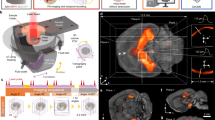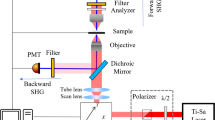Abstract
The morphology of viable taste disks of the frog was explored with multi-photon microscopy. In order to identify single sensory or supporting cells within the tissue, we searched for fluorescent dyes that stained subsets of the cell population or possibly cell types. Some cell types indeed stained preferentially with certain fluorescent dyes. A subset of glia-like cells (type Ic) stained with BCECF, a H+-sensitive dye, and indo-1, a Ca2+-sensitive dye, both presented in the membrane-permeant ester form. BCECF-ester also stained the dendrites of type III receptor cells, but indo-1 ester did not. Receptor cells of type II stained with MQAE, a positively charged Cl−-sensitive dye. A subset of type II cells accumulated amiloride, a positively charged fluorescent diuretic. Certain supporting cells, i.e., wing cells (type Ib) and glia-like cells (type Ic), were labeled by negatively charged dyes, e.g., calcium green-1 dextran. Mucus cells (type Ia) were stained with only two of the 19 dyes examined, and Merkel-like basal cells (type IV) were stained only with a membrane-labeling voltage-sensitive dye, presumably by endocytosis. No dye was found which would stain all types of cells or all receptor cells. This finding reveals a potential problem for future functional imaging aiming at population responses, as the responses of unstained cells then would remain unobserved. Specificity of dyes with respect to cell types was sufficient to identify supporting cells and receptor cells. Cell shape could then be reconstructed, using optical slicing and rendering techniques. Thus populations of dye-loaded elongated cells, especially types Ic, II and III, could for the first time be visualized in three dimensions.











Similar content being viewed by others
References
Abrahamse SL, Rechkemmer G (2001) Identification of an organic anion transport system in the human colon carcinoma cell line HT29 clone 19a. Pflugers Arch 441:529–537
Avenet P, Lindemann B (1987) Patch-clamp study of isolated taste receptor cells of the frog. J Membr Biol 97:223–240
Avenet P, Lindemann B (1988) Amiloride-blockable sodium currents in isolated taste receptor cells. J Membr Biol 105:245–255
Avenet P, Hofmann F, Lindemann B (1988) Transduction in taste receptor cells requires cAMP-dependent protein kinase. Nature 331:351–354
Bigiani A, Sbarbati A, Osculati F, Pietra P (1998) Electrophysiological characterization of a putative supporting cell isolated from the frog taste disk. J Neurosci 18:5136–5150
Briggman JV, Graves JS, Spicer SS, Cragoe EJ Jnr (1983) The intracellular localization of amiloride in frog skin. Histochem J 15:239–255
Brown D, Breton S (2000) Sorting proteins to their target membranes. Kidney Int 57:816–824
Burckhardt G, Wolff NA (2000) Structure of renal organic anion and cation transporters. Am J Physiol Renal Physiol 278:F853–F866
Caicedo A, Roper SD (2001) Taste receptor cells that discriminate between bitter stimuli. Science 291:1557–1560
Caicedo A, Jafri MS, Roper SD (2000a) In situ Ca2+ imaging reveals neurotransmitter receptors for glutamate in taste receptor cells. J Neurosci 20:7978–7985
Caicedo A, Kim KN, Roper SD (2000b) Glutamate-induced cobalt uptake reveals non-NMDA receptors in rat taste cells. J Comp Neurol 417:315–324
Denk W, Svoboda K (1997) Photon upmanship: why multiphoton imaging is more than a gimmick. Neuron 18:351–357
Eisenhofer G (2001) The role of neuronal and extraneuronal plasma membrane transporters in the inactivation of peripheral catecholamines. Pharmacol Ther 91:35–62
Guatimosim C, Gersdorff H von (2002) Optical monitoring of synaptic vesicle trafficking in ribbon synapses. Neurochem Int 41:307
Henkel AW, Lubke J, Betz WJ (1996) FM1–43 dye ultrastructural localization in and release from frog motor nerve terminals. Proc Natl Acad Sci USA 93:1918–1923
Jakob I, Hauser I, Thevenod F, Lindemann B (1998) MDR1 p-glycoprotein in taste buds of rat vallate papilla: functional, immunohistochemical and biochemical evidence. Am J Physiol 274:C182-C191
Kaneko H, Nakamura T, Lindemann B (2001) Non-invasive measurement of the chloride concentration in rat olfactory receptor cells, using a fluorescent dye. Am J Physiol 280:C1387-C1393
Kleyman TR, Cragoe EJ Jnr (1988) Amiloride and its analogs as tools in the study of ion transport. J Membr Biol 105:1–21
Koncz C, Daugirdas JT (1994) Use of MQAE for measurement of intracellular [Cl−] in cultured aortic smooth muscle cells. Am J Physiol 267:H2114–H2123
Kretz O, Barbry P, Bock R, Lindemann B (1999) Differential expression of RNA and protein of the three pore-forming subunits of the amiloride-sensitive epithelial sodium channel in taste buds of the rat. J Histochem Cytochem 47:51–64
Li Y, Zhu H, Kuppusamy P, Roubaud V, Zweier JL, Trush MA (1998) Validation of lucigenin (bis-n-methylacridinium) as a chemilumigenic probe for detecting superoxide anion radical production by enzymatic and cellular systems. J Biol Chem 273:2015–2023
Lindemann B (1997) Sodium taste. Curr Opin Nephrol Hypertension 6:425–429
Lindemann B (2001) Receptors and transduction in taste. Nature 413:219–225.
Lindemann B, Gilbertson TA, Kinnamon SC (1999) Amiloride sensitive sodium channels in taste. In: Benos DJ (ed) Amiloride sensitive sodium channels: physiology and functional diversity. Academic Press, San Diego, pp 315–336
Liu CY, Zhang H, Christofi FL (1998) Adenylyl cyclase co-distribution with the CABPS, calbindin-d28 and calretinin, varies with cell type: assessment with the fluorescent dye, bodipy forskolin, in enteric ganglia. Cell Tissue Res 293:57–73
Lobel D, Jacob M, Volkner M, Breer H (2002) Odorants of different chemical classes interact with distinct odorant binding protein subtypes. Chem Senses 27:39–44
Menco BP, Bruch RC, Dau B, Danho W (1992) Ultrastructural localization of olfactory transduction components: the G protein subunit Golf alpha and type III adenylyl cyclase. Neuron 8:441–453
Miyamoto T, Miyazaki T, Fujiyama R, Okada Y, Sato T (2001) Differential transduction mechanisms underlying NaCl- and KCl-induced responses in mouse taste cells. Chem Senses 26:67–77
Molecular Probes (2002) Home page. http://www.probes.com/
Mostov KE, Verges M, Altschuler Y (2000) Membrane traffic in polarized epithelial cells. Curr Opin Cell Biol 12:483–490
Nichols BJ, Kenworthy AK, Polishchuk RS, Lodge R, Roberts TH, Hirschberg K, Phair RD, Lippincott-Schwartz J (2001) Rapid cycling of lipid raft markers between the cell surface and golgi complex. J Cell Biol 153:529–541
Nicholson C, Tao L (1993) Hindered diffusion of high molecular weight compounds in brain extracellular microenvironment measured with integrative optical imaging. Biophys J 65:2277–2290
Novotny WF, Chassande O, Baker M, Lazdunski M, Barbry P (1994) Diamine oxidase is the amiloride-binding protein and is inhibited by amiloride analogues. J Biol Chem 269:9921–9925
Okada CY, Rechsteiner M (1982) Introduction of macromolecules into cultured mammalian cells by osmotic lysis of pinocytic vesicles. Cell 29:33–41
Osculati F, Sbarbati A (1995) The frog taste disk: a prototype of the vertebrate gustatory organ. Prog Neurobiol 46:351–399
Richter H-P, Avenet P, Mestres P, Lindemann B (1988) Gustatory receptors and neighbouring cells in the surface layer of an amphibian taste disc: in situ relationships and response to cell isolation. Cell Tissue Res 254:83–96
Sbarbati A, Crescimanno C, De Rossi V, Bernardi P, Osculati F (1999) NADPH-diaphorase and NOS-1 positive ganglion cells are found in the rat vallate papilla/von Ebner gland complex. Histochem J 31:417–424
Sbarbati A, Crescimanno C, Bernardi P, Benati D, Merigo F, Osculati F (2000) Postnatal development of the intrinsic nervous system in the circumvallate papilla-von Ebner gland complex. Histochem J 32:483–488.
Seamon KB, Padgett W, Daly JW (1981) Forskolin: unique diterpene activator of adenylate cyclase in membranes and in intact cells. Proc Natl Acad Sci USA 78:3363–3367
Simchowitz L, Woltersdorf OW Jnr, Cragoe EJ Jnr (1987) Intracellular accumulation of potent amiloride analogues by human neutrophils. J Biol Chem 262:15875–15885
Stevens DR, Seifert R, Bufe B, Muller F, Kremmer E, Gauss R, Meyerhof W, Kaupp UB, Lindemann B (2001) Hyperpolarization-activated channels HCN1 and HCN4 mediate responses to sour stimuli. Nature 413:631–635
Swanson J (1989) Fluorescent labeling of endocytic compartments. Methods Cell Biol 29:137–151
Tominaga T, Tominaga Y, Yamada H, Matsumoto G, Ichikawa M (2000) Quantification of optical signals with electrophysiological signals in neural activities of di-4-ANEPPS stained rat hippocampal slices. J Neurosci Methods 102:11–23
Tonder GJ van, Ejima Y (2000) Bottom-up clues in target finding: why a dalmatian may be mistaken for an elephant. Perception 29:149–157
Acknowledgements
We thank Andrea Sbarbati for valuable advice regarding the morphological details of taste disks, Albertino Bigiani for generously providing the frogs, and Markus Hoth and Eberhard Tutsch for advice regarding multi-photon microscopy.
Author information
Authors and Affiliations
Corresponding author
Additional information
This work was supported by the Deutsche Forschungsgemeinschaft (SFB 530, project B2)
Rights and permissions
About this article
Cite this article
Li, J.HY., Lindemann, B. Multi-photon microscopy of cell types in the viable taste disk of the frog. Cell Tissue Res 313, 11–27 (2003). https://doi.org/10.1007/s00441-003-0725-1
Received:
Accepted:
Published:
Issue Date:
DOI: https://doi.org/10.1007/s00441-003-0725-1




